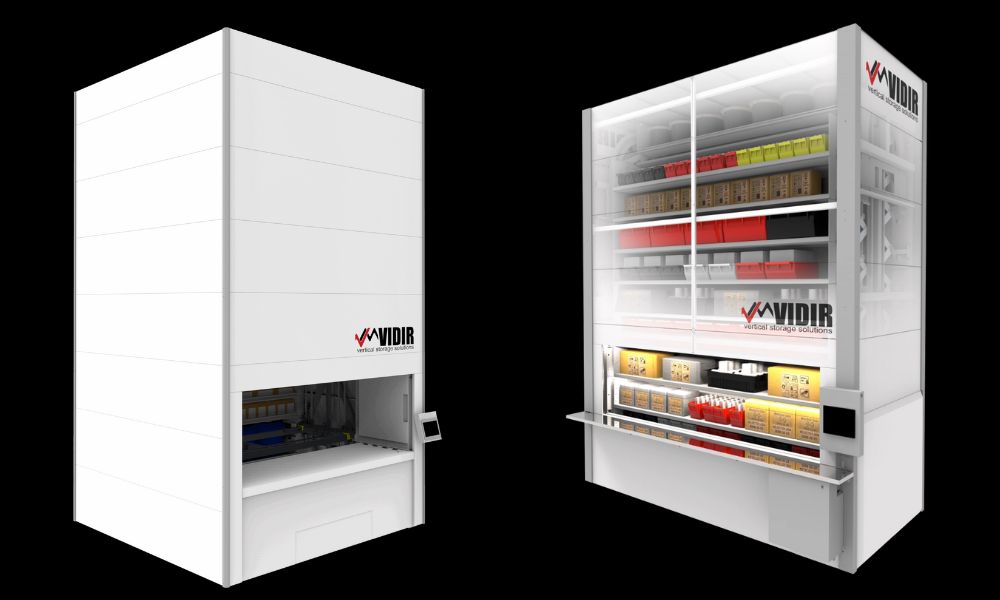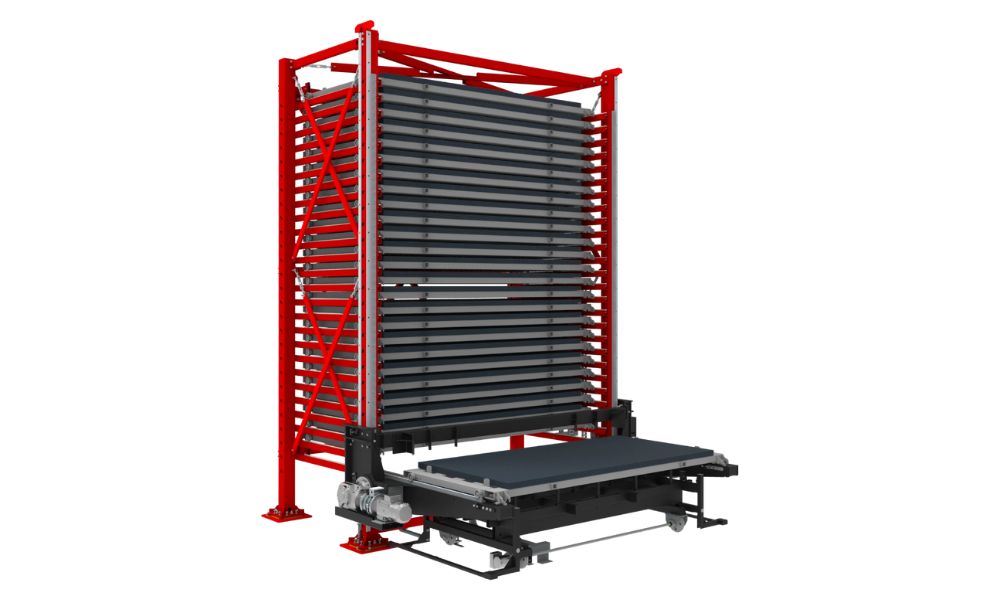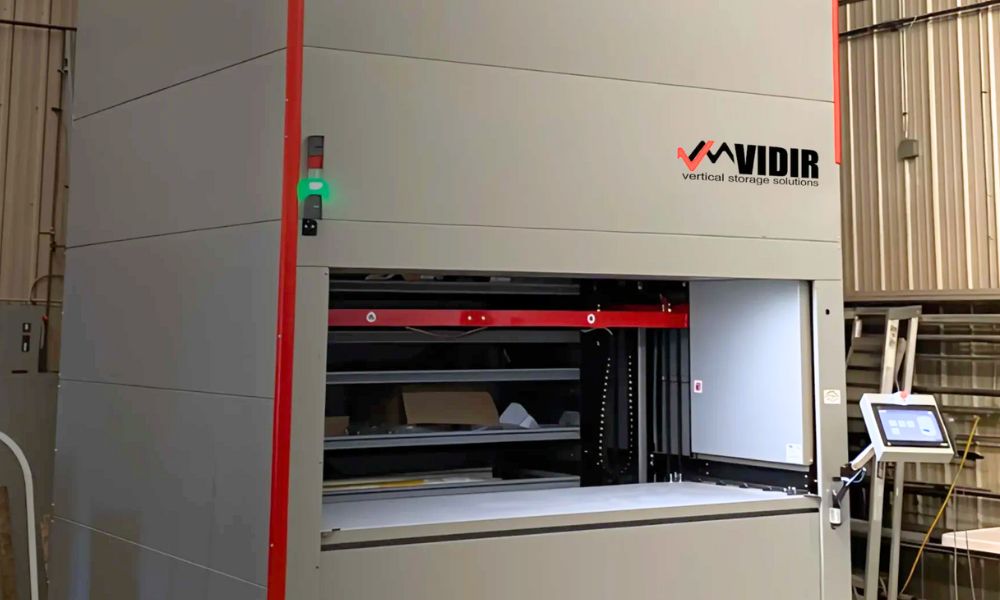Traditional storage methods often fail to address the growing demand for faster retrieval times, improved inventory accuracy, and optimal space management. As a solution, vertical lift modules (VLMs) transform storage operations from floor-consuming horizontal systems into space-efficient vertical setups. Learn why vertical lift modules are key for high-density storage, so you can integrate these systems into your facility for an improved workplace environment.
Understanding Vertical Lift Module Technology
Vertical lift modules operate on an automated storage and retrieval system that utilizes vertical space through intelligent design. These systems consist of two columns of adjustable shelving with an automated extractor mechanism that moves vertically between them. The extractor retrieves requested items and delivers them to an ergonomically positioned work counter, eliminating the need for personnel to climb, bend, or stretch during retrieval operations.
The system’s computer-controlled operation features precise inventory tracking and management. Advanced software integration allows operators to input item requests through user-friendly interfaces, and the system automatically locates and retrieves the required materials within seconds.
Height configurations for vertical lift modules typically range from 10 to 50 feet, with some specialized units reaching greater heights. The modular design accommodates various load capacities, from lightweight electronic components to heavy automotive parts. This makes VLMs versatile solutions for diverse industrial applications.
Space Optimization Through Vertical Integration
High-density storage demands innovative approaches to space utilization, and vertical lift modules deliver exceptional results. Traditional horizontal storage systems consume valuable floor space that could otherwise support production activities or additional storage capacity.
The space-saving capabilities of vertical lift modules often exceed 75% when compared to traditional shelving systems. This dramatic improvement comes from the reduction of aisles between storage units and the system’s ability to store items of varying heights within the same vertical space. The dynamic shelving adjustment feature offers additional space utilization by automatically configuring shelf heights based on stored item dimensions.
Facilities implementing VLMs frequently discover opportunities to consolidate multiple storage areas into single, compact units. This reduces the physical footprint required for storage operations while improving accessibility and inventory management capabilities. The resulting space savings create opportunities for facility expansion, additional production lines, or improved workflow layouts.

Enhanced Inventory Management
Vertical lift modules integrate inventory management systems that provide real-time tracking and monitoring capabilities. The computerized control system maintains detailed records of item locations, quantities, and movement history to eliminate the guesswork associated with manual inventory management. This precision reduces inventory discrepancies and is part of why vertical modules are key for high-density storage.
The system’s automated tracking capabilities provide comprehensive reporting features that analyze inventory turnover rates, identify slow-moving items, and optimize storage configurations based on retrieval patterns. These analytical capabilities enable facility managers to make informed decisions about inventory management strategies and storage optimization.
Barcode scanning and RFID integration further improve inventory accuracy by providing multiple verification points during storage and retrieval operations. The system automatically updates inventory records when items enter or exit the storage module to maintain accurate counts without manual intervention. This automation reduces human error and keeps inventory data current and reliable.
Operational Efficiency and Productivity Gains
Traditional storage systems require personnel to travel across the facility to locate and retrieve items, and this process often involves climbing ladders or navigating crowded aisles. VLMs cut back on these time-consuming activities by delivering requested items directly to workstations.
The implementation of vertical lift modules generates substantial improvements in operational efficiency through reduced retrieval times and streamlined workflows. Average retrieval times for VLM systems typically range from 15 to 45 seconds, regardless of an item’s location within the storage module. This consistency contrasts sharply with traditional storage methods, where retrieval times vary based on item location and accessibility.
The ergonomic advantages of vertical lift modules also contribute to enhanced worker productivity and reduced fatigue. Personnel no longer need to perform physically demanding activities such as climbing, reaching, or lifting heavy items from awkward positions. The system delivers items to comfortable working heights and improves worker satisfaction while maintaining high productivity levels.
Security and Environmental Protection
Vertical lift modules provide better security features compared to traditional open storage systems. The enclosed design restricts access to authorized personnel to protect valuable inventory from theft, damage, or contamination. Advanced access control systems track user activity and maintain detailed logs of all storage and retrieval operations. This creates comprehensive audit trails for security and compliance purposes.
Environmental protection represents another advantage of VLM systems. The enclosed storage environment shields sensitive materials from dust, moisture, and temperature fluctuations that can compromise product quality. Climate-controlled VLM units maintain optimal storage conditions for temperature-sensitive items, pharmaceuticals, and precision components that require specific environmental parameters.

Cost-Effectiveness and Return on Investment
While it may be an expensive investment at first, VLMs offer long-term financial benefits for storage facilities. The improved efficiency and reduced retrieval times enable facilities to accomplish more work with existing staff levels, effectively increasing productivity without additional labor costs.
Inventory carrying costs decrease through improved space utilization and enhanced inventory management capabilities. The ability to store more items in less space reduces the total cost of storage operations while improving inventory turnover rates. Improved inventory accuracy reduces the need for safety stock and minimizes write-offs associated with lost or damaged items.
Implementation Best Practices
Professional installers use load capacity analysis to choose a VLM system that accommodates current and anticipated storage needs. Weight distribution calculations also verify that building structures can support the fully loaded system, particularly for multistory installations or facilities with weight restrictions.
Integration with existing warehouse management systems demands careful attention to software compatibility and data exchange protocols. Modern VLM systems support various communication standards and can interface with most enterprise resource planning systems, but specific integration requirements should be verified during the planning phase.
After installing the lift module, training programs for facility personnel should cover system operation, maintenance procedures, and troubleshooting techniques. Well-trained operators maximize system efficiency and minimize downtime through proper operation and preventive maintenance practices.
You can renovate your storage facility by installing upgraded equipment that reduces downtime and improves employee productivity. The specialists at Warehouse Solutions will guide you through the vertical lift module installation process and help you design a mechanism that complements your layout. For more information regarding our services and products, contact our team for a consultation today.
